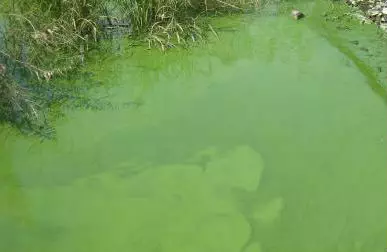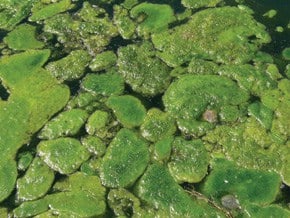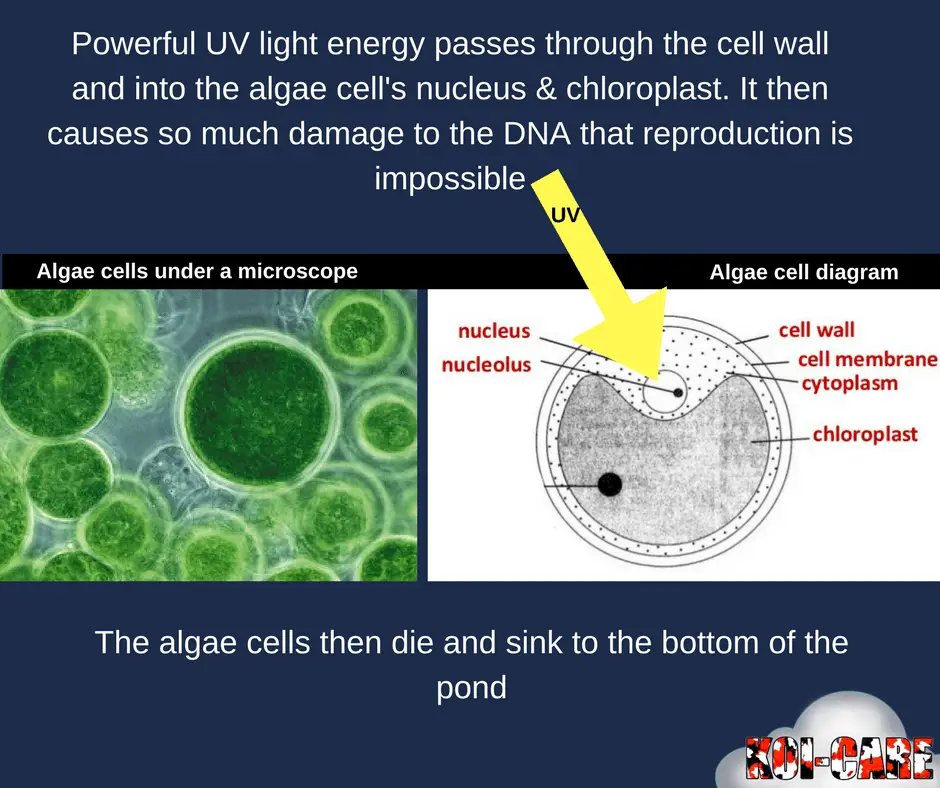How To Control Algae In Koi Pond
Information technology is the case that every spring, as temperatures ascent and daylight hours increase, an algal bloom occurs in near everyone's koi pond. Dreaded algal blooms, similar light-green water that make koi disappear from view or cruddy string algae that seems to pop up from nowhere, seem to be an inescapable fact of pond life. Being able to effectively control pond algae is going to be crucial.

There is a lot that happens during the transition from winter to leap. One thing that many koi owners experience is an increase in affliction. This increase is, in office, linked to the fact that little beasties like parasites are doing well in the increasing water temperatures but a koi's immune system is still coming dorsum into full strength so there is a menstruum in the leap when they are more than vulnerable.
Additionally, the increase in temperatures, sunlight and available nutrients from dead and decaying plant material and fish waste matter act to fuel algal growth and a bloom occurs. But what about the benign bacteria in the filter media?
They are all the same there but, like a koi's allowed system, are not at full force notwithstanding (more on beneficial bacteria subsequently). Algae are pretty uncomplicated as living things become. They need sunlight, carbon dioxide (given off from the gills of respiring koi and atmospheric CO2) and nutrients (nitrates, phosphates, ammonia etc.).
There is more to the story though when it comes to what algae need and how well they will do. Algae do well when pH is on the college side and this is because certain nutrients are more readily assimilated past the algae under these conditions.
Algae besides thrive under conditions of stagnant h2o or decreased water catamenia (yous've probably noticed that stagnant ponds tend to harbor a lot of algae). Different algae behave differently though- read on for the characteristics of the most problematic types.
Two principal types of algae
1) Phytoplanktonic (complimentary floating) which includes types that cause "green h2o" or "pea soup" water weather condition. This type of algae may be the most common to agonize pond owners. Spring is often when ponds turn into what appears to exist a big vat of pea soup-certainly not how koi keepers desire their ponds to look.
Also beingness a spring bloom occurrence, this single celled algae is often associated with newly established ponds also due to the fact that the filter hasn't had time to found a sufficiently large bacterial population nevertheless.

2) Benthic (fastened) which includes "string algae" or "horsehair algae", "water net" and "blanket weed". String algae tin can be a tough one. This algae can remain fallow for years in a dried land until introduced to h2o subsequently which it will thrive.
Another problem is that when you manually remove it from your pond (which is the best way) the action of removing information technology causes it to release reproductive spores into the water and the cycle starts once more.
Equally string algae tends to produce a skillful deal of dissolved oxygen it tends to aggregate bubbles tangled in its "hair" and earlier long a big, cruddy mat of the stuff floats to the surface further reducing the beauty of your pond.
Of course, something that produces dissolved oxygen in your swimming is a good thing, correct? Yes, up until the betoken that information technology dies, sinks to the lesser and is broken down by bacteria that utilise oxygen to do and so thereby depleting your swimming of dissolved oxygen.


Prevention
The following is a list of ways to prevent algal growth in your pond.
Shade
Sunlight is a big component that is necessary for algae to thrive so by shading your pond in some way yous can effectively reduce some of the potential algae fuel inbound your pond. One way yous tin do this is the old fashioned mode- copse. Try planting trees that provide awning overhead well-nigh your pond.
Besides aeriform shade there is likewise the aquatic kind. Pond owners have, for a long time, installed aquatic plants similar lilies in their pond to non but create shade but they make your pond more aesthetically highly-seasoned.
The "magic" number to shoot for when information technology comes to aquatic plant coverage is 60-70% surface coverage. Another way to reduce calorie-free penetration is through not-toxic coloring agents (dyes) that essentially tint your water a certain color and reduce the available lite in your pond.
This has become a "go-to" solution for enough of pond owners. They typically last a long time and you have a few dye colors to choose. If yous reduce the sunlight penetration y'all reduce algae's ability to thrive! Here are few good dye choices to bank check out.
Reduce Nutrient Loads
Nutrients like nitrates and phosphates are key to algal growth so by reducing and nullifying these components you tin can severely limit algae's ability to abound. This is achieved by not overfeeding your koi, past keeping close tabs on h2o chemistry and making adjustments as needed.
Brand sure your pond isn't subject to fertilizer runoff equally that volition often conduct a lot of phosphates. Be sure yous have plenty of filtration and beneficial bacteria to digest nutrients etc. You may also need to perform several water changes in an try to reduce nutrient loads.
If this is the example be certain that the water changes you lot do are gradual to ensure that your pond doesn't undergo a significant pH swing as this may cause damage to your koi. For more on how biological cycles piece of work meet this article.
Adding Salt
Table salt seems to be a go-to remedy for a lot of things in the globe of koi keeping and it turns out that it can help control algae blooms as well. There is a caveat with using salt to gainsay algae in your pond though and that relates to the fact that high enough salinities will likewise harm or impale your aquatic plants.
For case, common plants like water hyacinth and lotus volition begin to dice back at 0.10% whereas water lily won't dice off until 0.v% and to deal with algae finer you volition want to shoot for 0.25 to 0.30%. You will take to determine if salt makes sense for your algae problems based on your resident species of aquatic plants.
A good style to decide the right corporeality of common salt is to the use koi-care's online calculator and once added a simple fashion to bank check your salinity is with a commonly used tool called a refractometer.
UV Sterilizers
One of the nigh constructive ways of combating single celled algae like that which causes "green water" is an in-line UV sterilizer every bit part of your filtration system. Its an excellent and non-invasive fashion of dealing with certain types of algae (and harmful bacteria for that thing) that tin can easily exist added to your existing piping. So how does UV light kill algae? UV is a powerful kind of lite free energy and it finer penetrates the jail cell membrane on the outside of the algae cell and hits the areas of the algae where the DNA is (nucleus and chloroplast). Once this happens, the Dna gets so disrupted past the UV that the algae cell cannot reproduce.

UV Clarifiers are as well an option if y'all are simply targeting free floating algae but its less powerful (algae requires less powerful UV to be killed) so if you are going have a UV system you might too have i that is going to kill other microbes and bacteria, besides. For most ponds a xxx watt system should suffice but be sure that the light you are getting is rated for the number of gallons you take.
Beneficial Leaner
Besides UV sterilizers one of best things yous can exercise for your swimming is adding boosted beneficial bacteria. This is particularly true during spring time when your filter media is not ramped up like it would be in summer.
I of the more popular products on the market for getting your bacteria populations up is chosen Microbe-Elevator PL and they even have seasonal "blends" depending on your needs (and season).
Its more often than not a good idea to requite your bacteria a boost from time to fourth dimension but when it comes to algae y'all may find yourself in a bicycle where the algae dies (either naturally or via algaecides), information technology decomposes on the bottom and causes high levels of nutrients like ammonia and nitrates and those nutrients then fuel the next generation of algae.
Adding the beneficial bacteria will permit the nutrients to be assimilated before they go available for more algae thereby starving out future algal growth.
Koi Clay
Koi dirt is one of those additions to your koi swimming that can only help. This "stuff" is a natural way to add a lot of peachy minerals to your system and koi seem to dear it. Every bit a side effect it has been reported to really be effective at inhibiting and killing string algae.
It is a calcium bentonite dirt and when added to your swimming it will temporarily cloud information technology up. It clears upwards in a twenty-four hour period and will have added lots of benign minerals and removed toxins. It is said that Kentucky produces so many neat race horses because they swallow the grass growing in Kentucky'due south particularly calcium-rich soil.
Similarly, Japan'southward koi might be so revered because of the clay rich ponds in which they are raised. There'southward lot of not bad koi clays on the market but you lot desire ones that don't remain cloudy for extended periods.
Barley Straw
One algae treatment you may have heard about but is perhaps a bit unexpected is barley harbinger. You lot tin can become it as raw barley straw or its extract. This treatment for green h2o can take upwards to 30 days to really get going and the results can be hit or miss.
Some speculate that the barley straw works past breaking down and releasing a toxin that prevents algae while others suggest that the break down process produces hydrogen peroxide which creates a poor environment for algal growth.
Co-ordinate to Rutgers University no ane actually knows how barley straw prevents algal growth but its important to note that it prevents algae, it doesn't impale existing algae so it shouldn't be used as an algicide. This treatment is more constructive on gratis floating algae as opposed to cord algae and is typically used in the spring fourth dimension.
Chemicals for Treating Algae
Simazine
Most algaecides can be placed into ane of three categories: potassium permanganate-based, copper-based and simazine-based. Simazine is a commonly used algicide. The way this chemical works is by disrupting the photosynthetic process and thereby killing the algae. Circumspection should exist used with this chemical as information technology can harm or stunt the growth of your aquatic plants (equally they use photosynthesis, too).
Potassium Permanganate
Use potassium permanganate with caution. Not only is information technology used for parasites like costia merely will also readily kill algae yet you need to monitor the pond afterward yous add it. The dose should be effectually 1 teaspoon per thousand gallons to start but you lot may end upwardly adding more or doing more than treatments based on your needs and how much algae you lot have.
You volition need to double upwardly on your pond aeration as you will meet a lot of your fish come to the surface and gasp to go air. Proceed upward the treatment for nigh 8 hours and brand certain the treated pond water doesn't go through your filter media as your benign leaner will be killed off.
Potassium permanganate will go used up equally it kills the algae and parasites etc. so y'all won't have to do a big water change as you lot would if you added a lot of salt. It would be very helpful though to vacuum the bottom of your pond after the treatment is over and your fish aren't showing signs of stress.
Algae Fix
Algae fix can be placed in the "copper based" category. Most copper based algaecides are in the form of chelated copper (which lasts longer than other forms). It can be constructive as an algicide because information technology disrupts algae cell metabolism however as with well-nigh treatments there are some precautions to exist aware of.
Vascular plants like h2o clover won't exist affected past the copper but other plants that derive nutrients from the h2o itself may be negatively afflicted. The other thing to consider is copper's impact on invertebrate organisms like snails and crayfish. Because virtually invertebrates have copper-based hemolymph (blood) copper-based treatments will damage or impale these organisms.
Green Make clean
I of the newer products on the market, "Green Clean", kills algae via oxidation and results are very rapid. At that place is no remainder and information technology is non copper based. Though it is advertised as a "broad spectrum" algaecide users accept reported that it is best for string algae and not ideal for green water (costless floating) algae. The company provides a helpful demonstration video here. All the Greenish Clean fabric is in the offset four minutes.
Accu Clear
This solution is in the family unit of treatments that cause green water algae to flocculate (suspended materials class small clusters and sink to the bottom). The idea is that your filter volition take intendance of the rest but as mentioned previously if you don't vacuum the bottom afterward it'south a good thought to pump up your beneficial leaner populations to handle the excess nutrient fallout from the decay of the algae.
Conclusion
Every swimming owner will, at some point, have to bargain with algae. Typically people volition struggle with it during the springtime when temperatures ascension but fortunately there are plenty of get-to solutions.
There are some that are broad spectrum and some that are will target one kind of algae or some other. The solution that is right for you lot is the i that meets your particular needs. There are enough of algaecide chemicals available on the market place today and a lot of pond owners will attest to their effectiveness.
Even so, if you notice yourself overrun by algae and don't know where to start try some of the solutions constitute nether "Prevention" in this article commencement earlier calculation chemicals. You may take to go the chemic route though and if you do be sure to couple those treatments with some of the preventative measures talked about or you may find yourself in the same situation before too long.
Main Points
- Shade is a great way to reduce one of the components algae needs to grow: sunlight.
- Reducing backlog nutrients is some other effective way to minimize algae food.
- Salt can be effective at keeping algae at bay. Algae likes fresh h2o so a footling table salt goes a long way.
- Green h2o algae tin can't stand up to UV sterilizers. The powerful light energy destroys the cells.
- Benign bacteria are your natural defence force against a build upward of nutrients that tin potentially fuel algal growth.
- Cord algae can be effectively treated with a time-honored application of koi clay. Koi really love the stuff also!
- Barley straw has been shown to be an effective prevention treatment for future algae episodes.
- There's lot of other ways to assail algae too. Algae Gear up goes later on algae cell metabolism, Green Clean is a very effective oxidizer and AccuClear is a flocculator (grabs suspended materials like green water algae).
How To Control Algae In Koi Pond,
Source: https://koi-care.com/getting-rid-of-algae/
Posted by: buckleypase1998.blogspot.com


0 Response to "How To Control Algae In Koi Pond"
Post a Comment